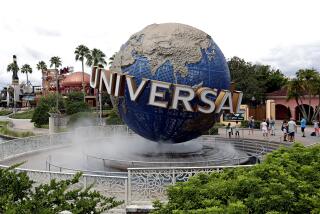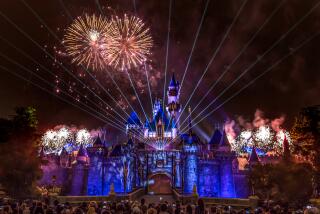At Star Wars: Galaxy’s Edge, visitors can fly — and buy
- Share via
Blue milk like Luke Skywalker drank on Tatooine: $8 a glass. A heavy-duty customized lightsaber: $200. An adult-size stormtrooper outfit: $6,615.
As Disneyland throws open the gates Friday to Star Wars: Galaxy’s Edge, the theme park will push the boundaries of the known merchandising universe as never before.
The much-anticipated 14-acre land opens with only one of two rides in operation, leaving visitors plenty of time to spend heavily at the five shops, a space-themed cantina and four restaurants and food stalls.
And those shops and restaurants won’t be selling typical theme-park knickknacks or carnival cuisine. The $1-billion expansion will instead cater primarily to adult Star Wars fanatics who won’t mind dropping serious Earth currency on a customized droid ($100).
“With Star Wars, they have a lot of hardcore fans that want to try something new and weird and don’t want to try Chicken McNuggets when they go to Galaxy’s Edge,” said Martin Lewison, a theme park expert and business management professor at Farmingdale State College in New York.
The Star Wars-themed land in Anaheim, and a second in Florida opening Aug. 29, reflect Walt Disney Co. Chief Executive Bob Iger’s ambitions to expand the Burbank company’s lucrative theme parks and resorts division and find new ways to leverage the Star Wars characters it acquired from Lucasfilm in 2012 for $4 billion. In fiscal 2018, the theme parks and resorts division’s operating income grew 18% to contribute $4.5 billion of Disney’s $15.7 billion in overall operating income.
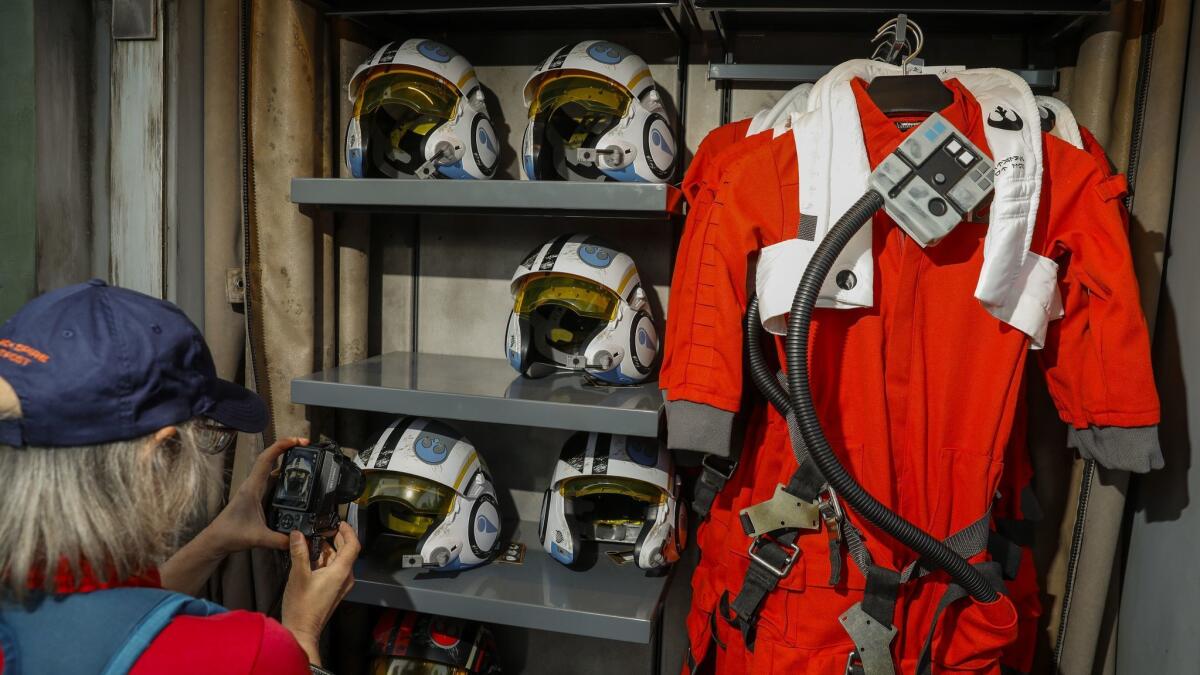
The heavy emphasis on high-priced food and specialty merchandise sales reflects the theme park industry’s direction in recent years, with Disney parks at the forefront.
In the U.S., the average theme park generates up to 30% of its revenue from the sale of food, beverages and merchandise, with admission and parking contributing the rest.
But in the past few years, leading theme park companies have created unique offerings tied to the park’s attractions, and they’re pocketing up to 40% or more from food, drinks and merchandise, said Ken Whiting, vice chair for the International Assn. of Amusement Parks & Attractions.
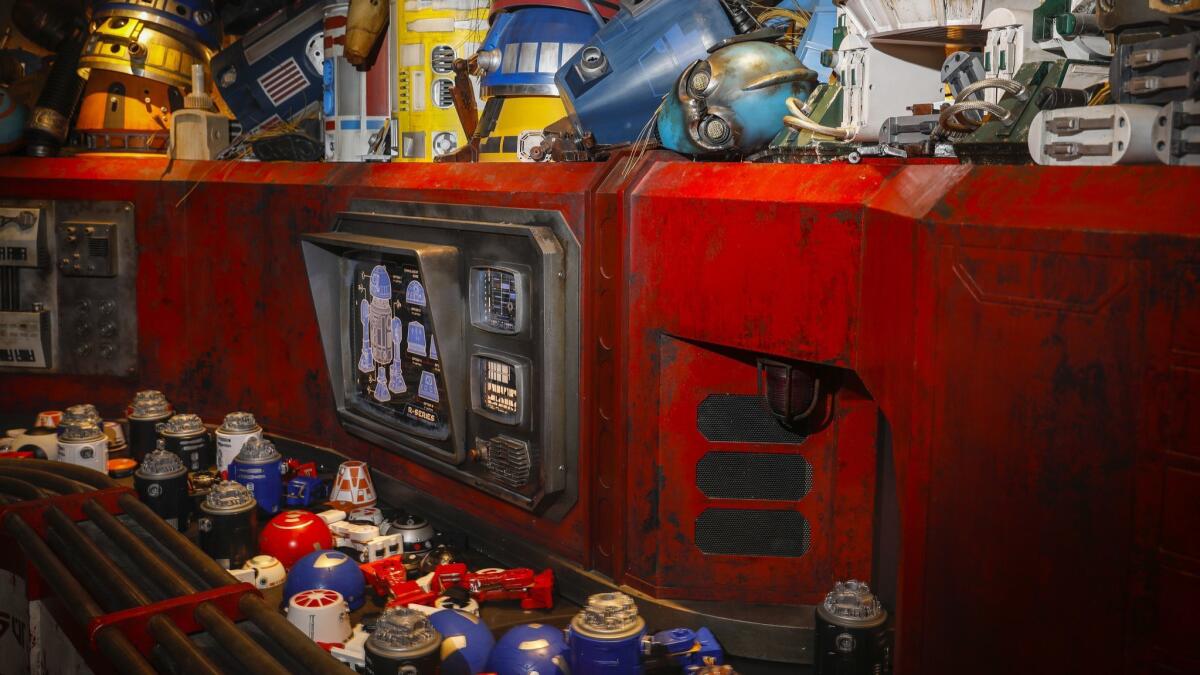
FULL COVERAGE: Star Wars: Galaxy’s Edge »
A prime example are the mugs of frothy butterbeer that went on sale for $6.50 (now $7.49) when the Wizarding World of Harry Potter opened in 2016 at Universal Studios Hollywood. The queues to buy the favorite drink of Harry Potter and his wizarding pals were almost as long as the lines for the attractions.
The increased sales of such novelty drinks and foods has been bolstered by the popularity of social media sites like Facebook and Instagram, where theme park visitors can post images of themselves holding up the latest concoction.
“Five years ago I would have said, ‘No way, no how. That is ridiculous,’” Whiting said. “Today that is occurring often and creating the intended results: people buying something just to snap their picture.”
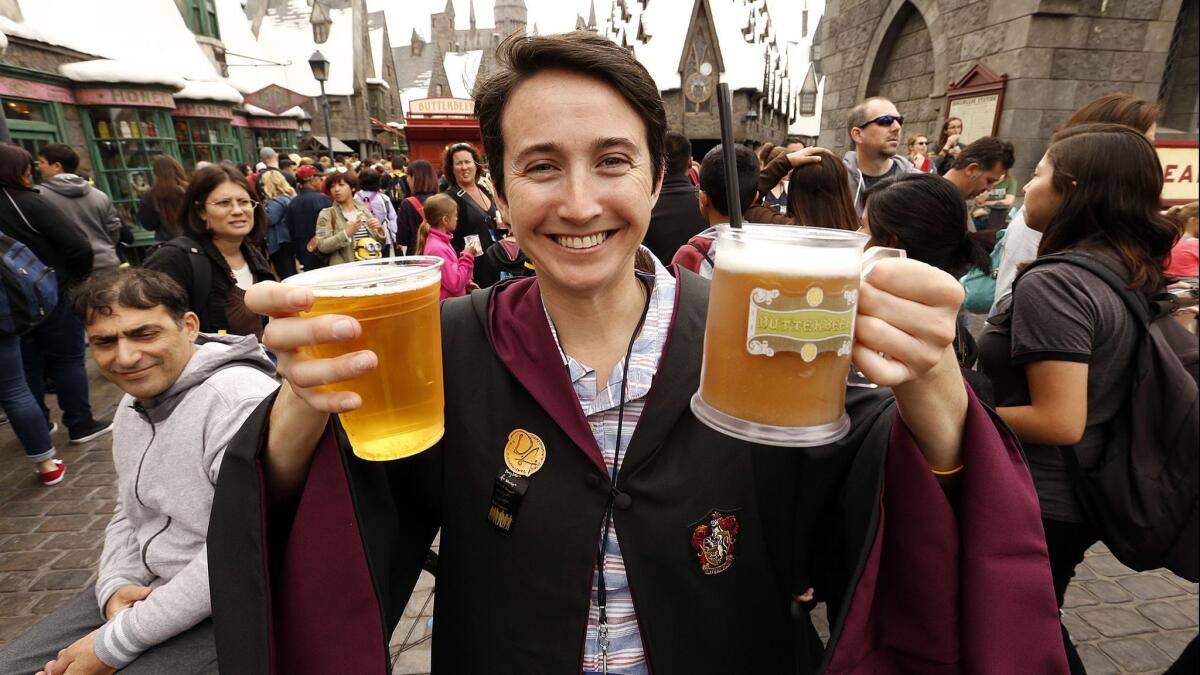
Modern attractions are increasingly designed to push theme park visitors to spend, with riders directed to exit through a souvenir shop that is brimming with clothes and knickknacks themed to the ride.
Technological advances such as Disney’s FastPass and Universal Studios parks’ Express Pass, combined with smartphone apps, have reduced time standing in line so more time can be devoted to shopping and eating.
The Walt Disney Co. has been an industry leader in this regard, offering a new selection of merchandise and food for nearly every season of the year and with the launch of each new attraction.
When Disneyland celebrated a Star Wars festival called “Season of the Force” in 2015, the menu items in Tomorrowland included a dessert called “Darth by Chocolate” for $5.99 and the Cheese-3PO Burger for $9.99, plus a drink with a glowing, floating replica of the Millennium Falcon for $7.59.
This explains why Disney, the world’s largest theme park operator, generates as much as $7 billion a year from food, beverages and merchandise sales, Lewison said. “We are talking big money,” he said.
Generating revenue from food, drinks and souvenirs became an even a bigger priority for Disney with the surprise Lucasfilm purchase.
Everything to know about Disneyland’s Star Wars: Galaxy’s Edge »
“Once you’ve made an investment, to get people there to your mega-attraction, now you have to look at recovering the investment,” said Bill Coan, chief executive of Itec Entertainment, a developer of theme park attractions and shows, and former Walt Disney Imagineering employee. “The gate doesn’t cover it.”
The new Star Wars-inspired land is designed to resemble a remote settlement named Black Spire Outpost on the planet Batuu, a hideaway for outlaws, smugglers and rebels fighting the evil Empire. In addition to life-size versions of the Millenium Falcon and an X-Wing Starfighter, the area features a marketplace with the feel of a Middle Eastern bazaar.
“The land acts as its own E-ticket attraction,” said Scott Trowbridge, creative executive for Walt Disney Imagineering, the creative arm of the company.
Only one ride — the video game-like Millennium Falcon: Smugglers Run — is operational. The second Galaxy’s Edge attraction — the ambitious, multi-vehicle Star Wars: Rise of the Resistance — is promised for later in the year.
Disneyland representatives say the sale of lightsabers, stormtrooper uniforms and blue milk are all part of giving visitors the Star Wars experience.
“Every aspect of our business is transporting guests of all generations on the adventures they came to enjoy,” Disneyland spokeswoman Liz Jaeger said.
Disneyland executives acknowledge that some of the prices may seem high, but they say some of the merchandise is aimed for collectors and super fans.
“The only concern we have with the price is that we are giving the right price for the right value,” said Brad Schoeneberg, Disney’s director of merchandise strategy and new park experience development.
The $7.99 blue milk — a mixture of coconut milk, rice milk, dragon fruit, pineapple, lime and watermelon — is made to resemble the drink that Star Wars hero Luke Skywalker drank in the blockbuster movie franchise.
Another way Disney plans to draw big revenue from the new land is to serve at least 10 premixed alcoholic drinks at Oga’s Cantina in Galaxy’s Edge — a first for the theme park.
The only other place to buy booze in Disneyland is at the private Club 33, the exclusive dinner club in Disneyland’s New Orleans Square. Walt Disney himself opposed the sale of alcohol in his parks, saying it would ruin the family atmosphere.
Still, Michele Gendreau, director of food and beverage for the Disneyland Resort, notes that the cantina also sells non-alcoholic drinks. “It is meant to be a family experience,” she said.
A quick survey during a Thursday media event uncovered relatively inexpensive souvenirs such as a black stone with Star Wars symbols and expressions, called “Sith Wisdom Tokens” for $3.99 apiece and Star Wars salad tongs for $15.
But many of the prices were much higher, including a robe for $125, a “Jedi Temple Guard Mask” for $130, a bust of Darth Vader for $110 and a salad bowl shaped like R2-D2 for $75. (Walmart.com carries adult-size Jedi robes for less than $20, but there weren’t any online reviews discussing the quality.)
Disneyland’s priciest Star Wars keepsake may be the life-size, automated R2-D2 for $25,000.
But simply having a fat wallet won’t guarantee parkgoers can walk away with such swanky souvenirs.
To buy a customized lightsaber, visitors may need an appointment to enter a store called Savi’s Workshop, which can accommodate only up to 14 people at a time.
The price of $199.99 plus tax doesn’t seem to faze some fans who have already vowed on social media sites to shell out the money.
At the Droid Depot, parkgoers can assemble a customized droid — either a BB series (such as the BB-8) or an R series (such as R2-D2) — with various parts and colors. The price: $99.99, plus tax.
Lewison said such prices may sound outrageous to some, but he expects the only problem for Disneyland employees will be keeping the shelves stocked.
He noted that when Universal Studios Orlando opened its version of the Wizarding World of Harry Potter in 2010, souvenir wizard robes were priced at $100. That didn’t stop Potter fans from standing in long lines to buy a robe, Lewison said.
“One of the reasons we go to theme parks is to live our fantasies, and parks are super sophisticated about letting you take that home with you,” he said. “It’s just smart business. If they don’t do it, they are leaving money on the table.”
To read more about the travel and tourism industries, follow @hugomartin on Twitter.
More to Read
Inside the business of entertainment
The Wide Shot brings you news, analysis and insights on everything from streaming wars to production — and what it all means for the future.
You may occasionally receive promotional content from the Los Angeles Times.

